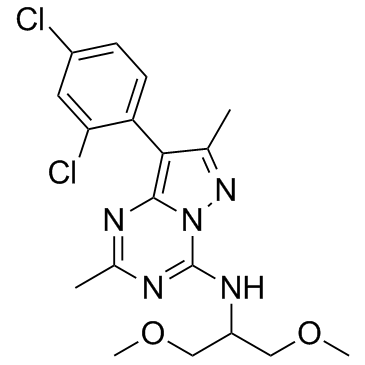202578-52-7
| Name | 8-(2,4-Dichlorophenyl)-N-(1,3-dimethoxy-2-propanyl)-2,7-dimethylp yrazolo[1,5-a][1,3,5]triazin-4-amine |
|---|---|
| Synonyms |
Pyrazolo[1,5-a]-1,3,5-triazin-4-amine, 8-(2,4-dichlorophenyl)-N-[2-methoxy-1-(methoxymethyl)ethyl]-2,7-dimethyl-
8-(2,4-Dichlorophenyl)-N-(1,3-dimethoxy-2-propanyl)-2,7-dimethylpyrazolo[1,5-a][1,3,5]triazin-4-amine DMP 696 |
| Description | DMP 696 is a selective corticotropin-releasing hormone receptor 1 (CRHR1) antagonist, used for the treatment of anxiety and depression. |
|---|---|
| Related Catalog | |
| In Vivo | DMP696 (3 mg/kg, p.o.) attenuates consolidation of remote fear memories of mice, without affecting their expression and retention. WT mice treated with DMP696 for 1 week starting 24 h after foot shock also show reduced synaptosomal GluR1 levels than do shocked vehicle-treated controls[1]. Rats treated with different doses of DMP696 (1, 3, 10, 30 mg/kg) show very little freezing during the 2-minute preshock interval. Rats treated with DMP696 exhibit a significant overall reduction in CREB phosphorylation, in both the LA, and BLA, but not in the CeA. DMP696 treatment reduces levels of LA and BLA pCREB across all time intervals that do not differ significantly from homecage pCREB levels (P>0.05). In the CeA, both vehicle- and DMP696-treated rats exhibit significantly higher pCREB expression at each post-conditioning time interval than homecage pCREB levels. Rats in the 30 ng DMP696 group exhibit significantly less freezing in comparison to vehicle-treated animals[2]. |
| Animal Admin | DMP696 is dissolved in saccharose-flavored NaCl 0.9% containing 10% DMSO, 10% PEG 400, and Tween-80 (1 drop/mL). Drug suspension is delivered on an oat flake and then fed to animals at a final dose of 3 mg/kg. Controls receive an oat flake soaked with saccharose-flavored vehicle only. The dose of 3 mg/kg is chosen on the basis of pilot experiments in which doses of 3, 10, and 30 mg/kg have been compared. The drug solutions are always freshly pipetted onto the flake and shortly dried before delivery. Ad libitum-fed mice receive some saccharose-flavored oat flakes 2 days before starting an experiment to habituate them to the novel food. Over the course of treatment, mice show no signs of aversion against the drug-soaked flakes, but readily ate them within a few seconds after delivery. |
| References |
| Density | 1.4±0.1 g/cm3 |
|---|---|
| Molecular Formula | C18H21Cl2N5O2 |
| Molecular Weight | 410.298 |
| Exact Mass | 409.107239 |
| PSA | 73.57000 |
| LogP | 3.32 |
| Index of Refraction | 1.634 |
| Storage condition | 2-8℃ |
